Abstract
The relationship between advanced maternal age and increased risk of trisomic offspring is well known clinically but not clearly understood at the level of the oocyte. A total of 383 oocytes that failed fertilization from 107 patients undergoing in vitro fertilization were analyzed by FISH using X-, 18-, and 13/21-chromosome probes simultaneously. The corresponding polar bodies were also analyzed in 188 of these oocytes. The chromosomes in the oocyte and first polar body complement each other and provide an internal control to differentiate between aneuploidy and technical errors. Two mechanisms of nondisjunction were determined. First, nondisjunction of bivalent chromosomes resulting in two univalents going to the same pole and, second, nondisjunction by premature chromatid separation (predivision) of univalent chromosomes producing either a balanced (2 + 2) or unbalanced (3 + 1) distribution of chromatids into the first polar body and M-II oocytes. Balanced predivision of chromatids, previously proposed as a major mechanism of aneuploidy, was found to increase significantly with time in culture (P < .005), which suggests that this phenomenon should be interpreted carefully. Unbalanced predivision and classical nondisjunction were unaffected by oocyte aging. In comparing oocytes from women <35 years of age with oocytes from women > or = 40 years of age, a significant increase (P < .001) in nondisjunction of full dyads was found in the oocytes with analyzable polar bodies and no FISH errors. Premature predivision of chromatids was also found to cause nondisjunction, but it did not increase with maternal age.
Full text
PDF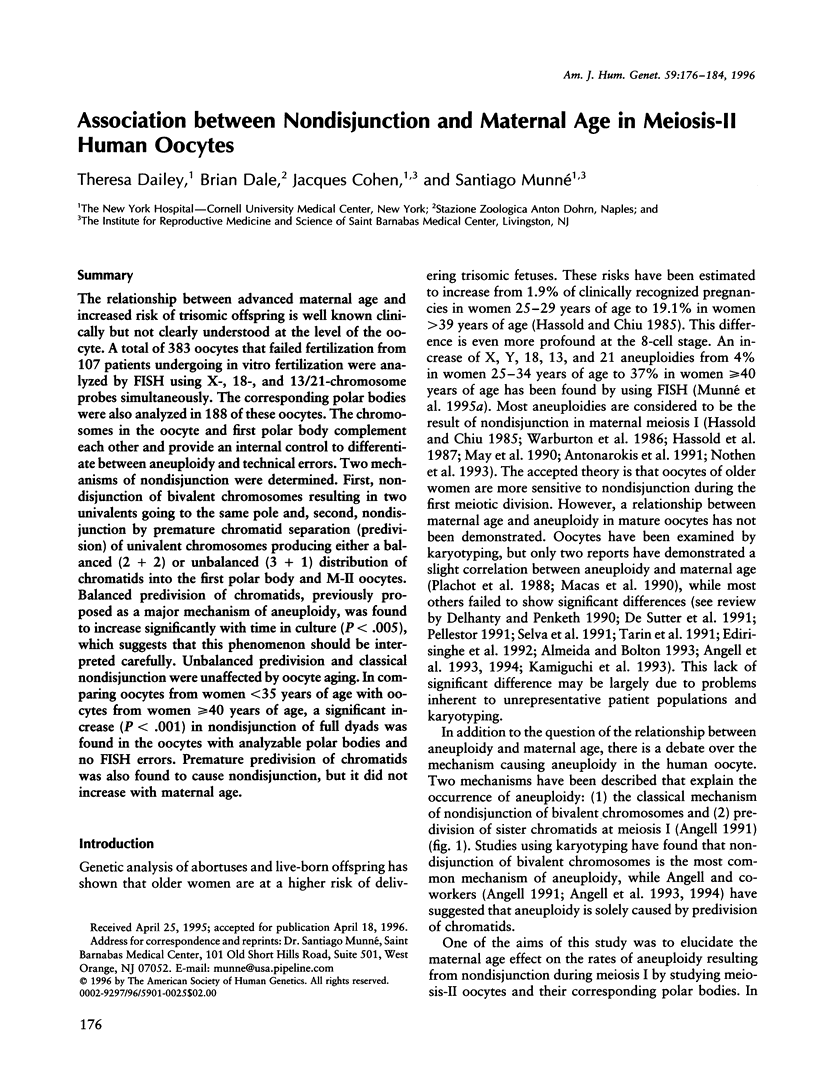
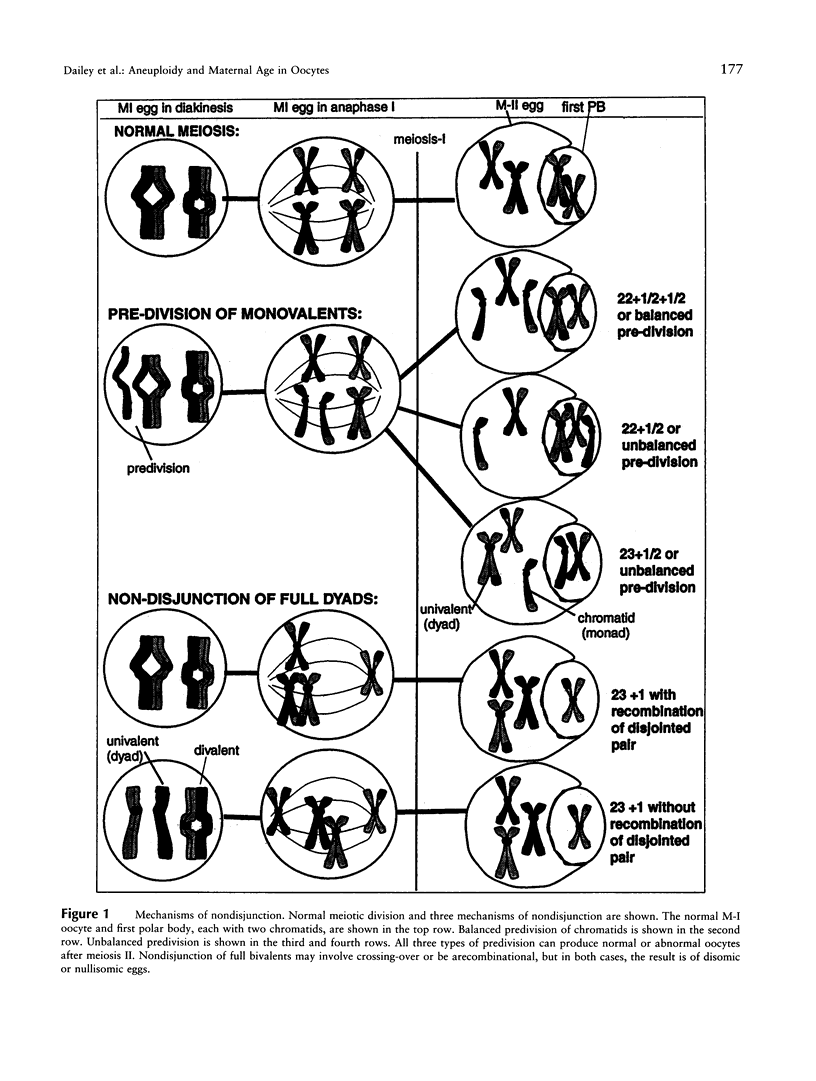
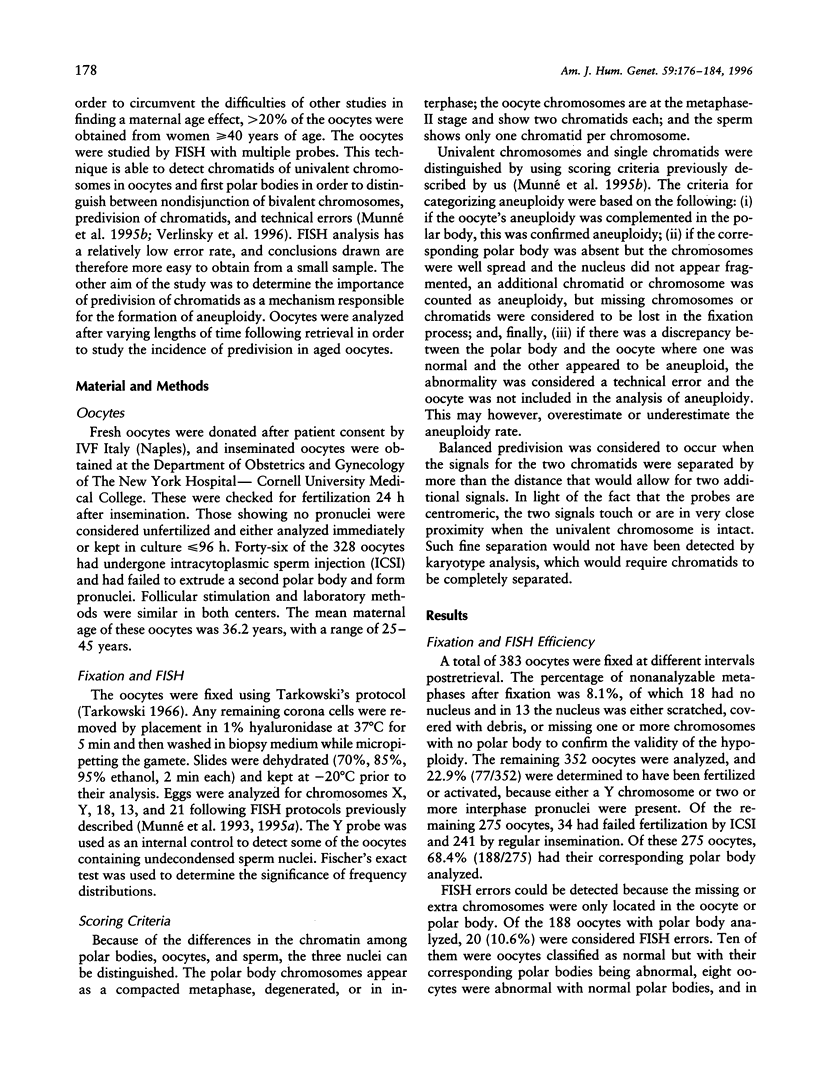
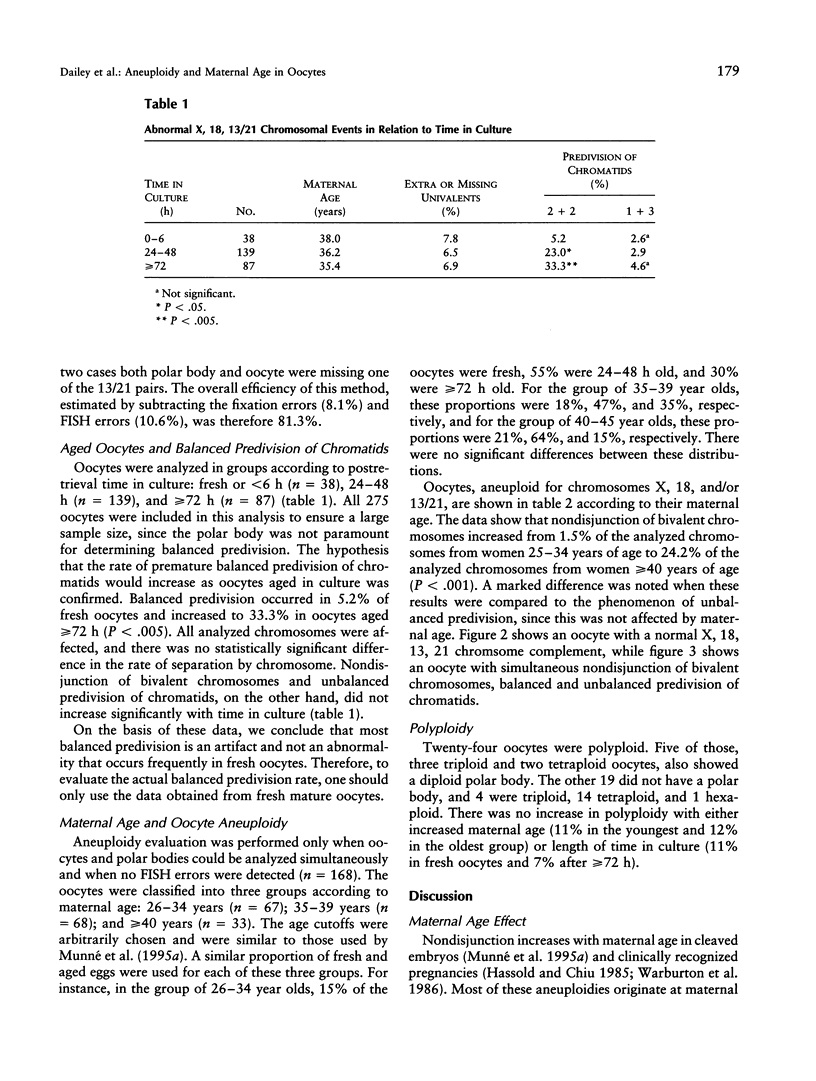



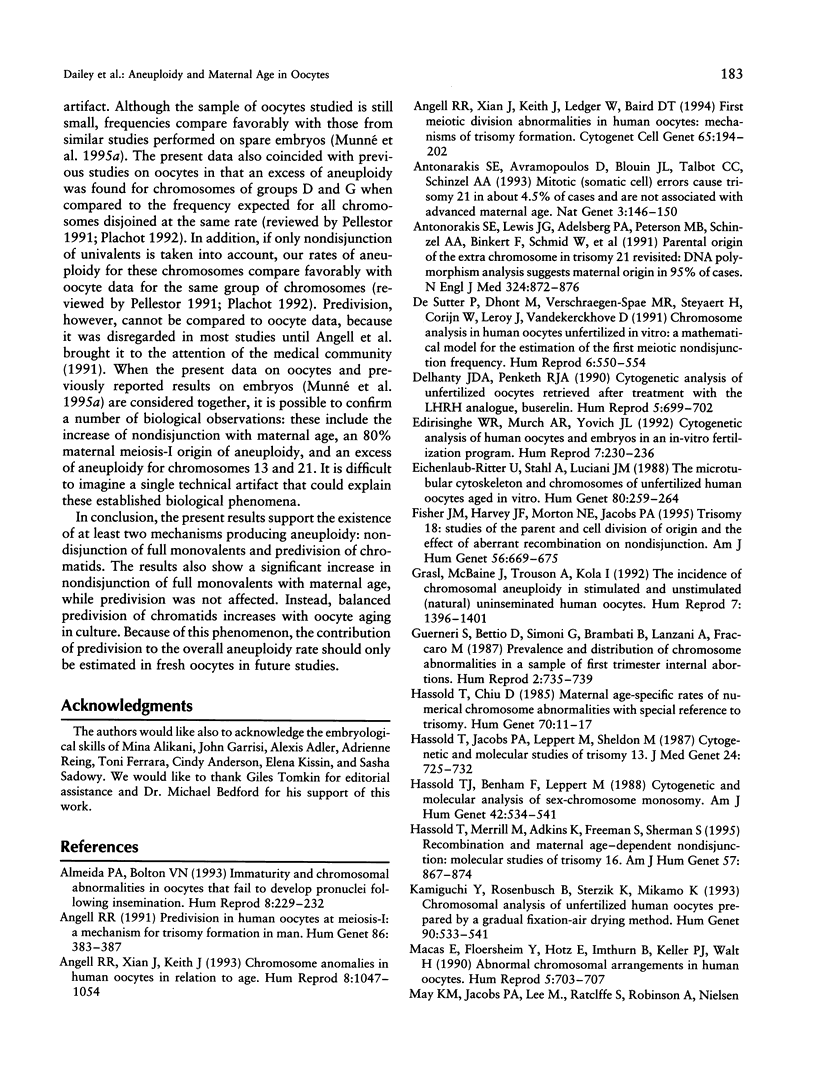
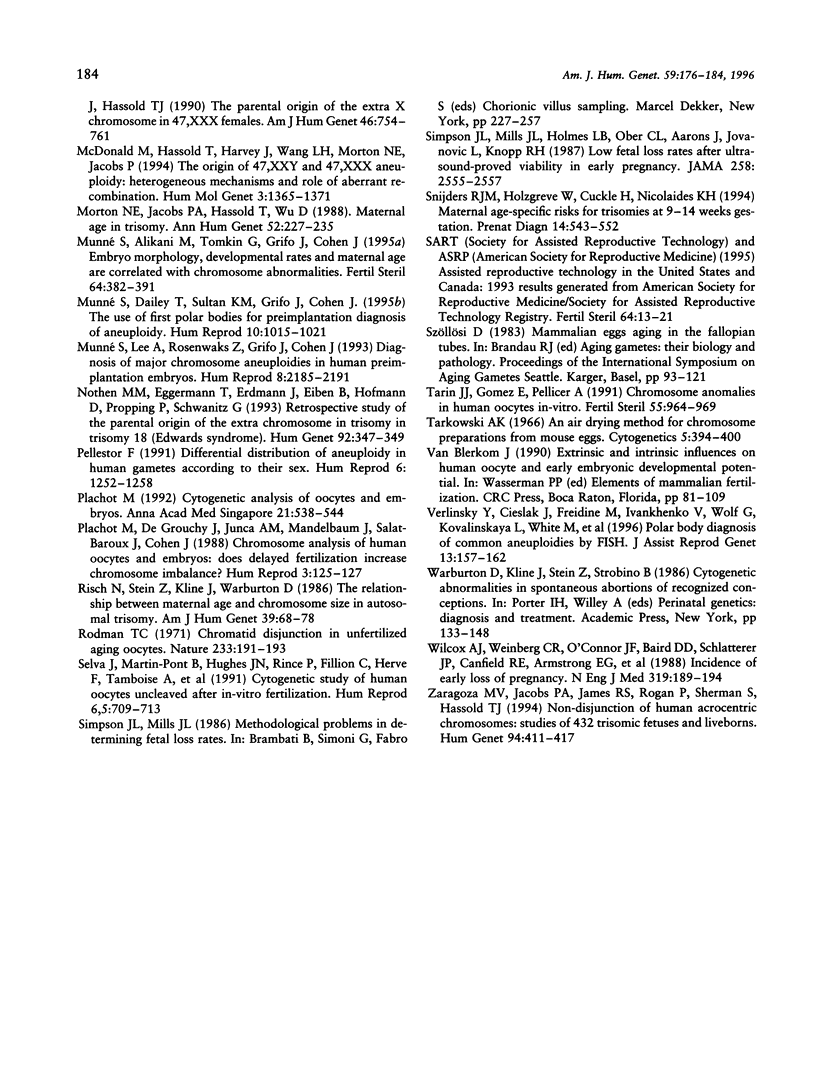
Images in this article
Selected References
These references are in PubMed. This may not be the complete list of references from this article.
- Almeida P. A., Bolton V. N. Immaturity and chromosomal abnormalities in oocytes that fail to develop pronuclei following insemination in vitro. Hum Reprod. 1993 Feb;8(2):229–232. doi: 10.1093/oxfordjournals.humrep.a138028. [DOI] [PubMed] [Google Scholar]
- Angell R. R. Predivision in human oocytes at meiosis I: a mechanism for trisomy formation in man. Hum Genet. 1991 Feb;86(4):383–387. doi: 10.1007/BF00201839. [DOI] [PubMed] [Google Scholar]
- Angell R. R., Xian J., Keith J. Chromosome anomalies in human oocytes in relation to age. Hum Reprod. 1993 Jul;8(7):1047–1054. doi: 10.1093/oxfordjournals.humrep.a138190. [DOI] [PubMed] [Google Scholar]
- Angell R. R., Xian J., Keith J., Ledger W., Baird D. T. First meiotic division abnormalities in human oocytes: mechanism of trisomy formation. Cytogenet Cell Genet. 1994;65(3):194–202. doi: 10.1159/000133631. [DOI] [PubMed] [Google Scholar]
- Antonarakis S. E., Avramopoulos D., Blouin J. L., Talbot C. C., Jr, Schinzel A. A. Mitotic errors in somatic cells cause trisomy 21 in about 4.5% of cases and are not associated with advanced maternal age. Nat Genet. 1993 Feb;3(2):146–150. doi: 10.1038/ng0293-146. [DOI] [PubMed] [Google Scholar]
- Antonarakis S. E. Parental origin of the extra chromosome in trisomy 21 as indicated by analysis of DNA polymorphisms. Down Syndrome Collaborative Group. N Engl J Med. 1991 Mar 28;324(13):872–876. doi: 10.1056/NEJM199103283241302. [DOI] [PubMed] [Google Scholar]
- De Sutter P., Dhont M., Verschraegen-Spae M. R., Steyaert H., Corijn W., Leroy J., Vandekerckhove D. Chromosome analysis in human oocytes unfertilized in vitro: a mathematical model for the estimation of the first meiotic non-disjunction frequency. Hum Reprod. 1991 Apr;6(4):550–554. doi: 10.1093/oxfordjournals.humrep.a137378. [DOI] [PubMed] [Google Scholar]
- Delhanty J. D., Penketh R. J. Cytogenetic analysis of unfertilized oocytes retrieved after treatment with the LHRH analogue, buserelin. Hum Reprod. 1990 Aug;5(6):699–702. doi: 10.1093/oxfordjournals.humrep.a137171. [DOI] [PubMed] [Google Scholar]
- Edirisinghe W. R., Murch A. R., Yovich J. L. Cytogenetic analysis of human oocytes and embryos in an in-vitro fertilization programme. Hum Reprod. 1992 Feb;7(2):230–236. doi: 10.1093/oxfordjournals.humrep.a137623. [DOI] [PubMed] [Google Scholar]
- Eichenlaub-Ritter U., Stahl A., Luciani J. M. The microtubular cytoskeleton and chromosomes of unfertilized human oocytes aged in vitro. Hum Genet. 1988 Nov;80(3):259–264. doi: 10.1007/BF01790094. [DOI] [PubMed] [Google Scholar]
- Fisher J. M., Harvey J. F., Morton N. E., Jacobs P. A. Trisomy 18: studies of the parent and cell division of origin and the effect of aberrant recombination on nondisjunction. Am J Hum Genet. 1995 Mar;56(3):669–675. [PMC free article] [PubMed] [Google Scholar]
- Gras L., McBain J., Trounson A., Kola I. The incidence of chromosomal aneuploidy in stimulated and unstimulated (natural) uninseminated human oocytes. Hum Reprod. 1992 Nov;7(10):1396–1401. doi: 10.1093/oxfordjournals.humrep.a137581. [DOI] [PubMed] [Google Scholar]
- Guerneri S., Bettio D., Simoni G., Brambati B., Lanzani A., Fraccaro M. Prevalence and distribution of chromosome abnormalities in a sample of first trimester internal abortions. Hum Reprod. 1987 Nov;2(8):735–739. doi: 10.1093/oxfordjournals.humrep.a136623. [DOI] [PubMed] [Google Scholar]
- Hassold T., Benham F., Leppert M. Cytogenetic and molecular analysis of sex-chromosome monosomy. Am J Hum Genet. 1988 Apr;42(4):534–541. [PMC free article] [PubMed] [Google Scholar]
- Hassold T., Chiu D. Maternal age-specific rates of numerical chromosome abnormalities with special reference to trisomy. Hum Genet. 1985;70(1):11–17. doi: 10.1007/BF00389450. [DOI] [PubMed] [Google Scholar]
- Hassold T., Jacobs P. A., Leppert M., Sheldon M. Cytogenetic and molecular studies of trisomy 13. J Med Genet. 1987 Dec;24(12):725–732. doi: 10.1136/jmg.24.12.725. [DOI] [PMC free article] [PubMed] [Google Scholar]
- Hassold T., Merrill M., Adkins K., Freeman S., Sherman S. Recombination and maternal age-dependent nondisjunction: molecular studies of trisomy 16. Am J Hum Genet. 1995 Oct;57(4):867–874. [PMC free article] [PubMed] [Google Scholar]
- Kamiguchi Y., Rosenbusch B., Sterzik K., Mikamo K. Chromosomal analysis of unfertilized human oocytes prepared by a gradual fixation-air drying method. Hum Genet. 1993 Jan;90(5):533–541. doi: 10.1007/BF00217454. [DOI] [PubMed] [Google Scholar]
- MacDonald M., Hassold T., Harvey J., Wang L. H., Morton N. E., Jacobs P. The origin of 47,XXY and 47,XXX aneuploidy: heterogeneous mechanisms and role of aberrant recombination. Hum Mol Genet. 1994 Aug;3(8):1365–1371. doi: 10.1093/hmg/3.8.1365. [DOI] [PubMed] [Google Scholar]
- Macas E., Floersheim Y., Hotz E., Imthurn B., Keller P. J., Walt H. Abnormal chromosomal arrangements in human oocytes. Hum Reprod. 1990 Aug;5(6):703–707. doi: 10.1093/oxfordjournals.humrep.a137172. [DOI] [PubMed] [Google Scholar]
- May K. M., Jacobs P. A., Lee M., Ratcliffe S., Robinson A., Nielsen J., Hassold T. J. The parental origin of the extra X chromosome in 47,XXX females. Am J Hum Genet. 1990 Apr;46(4):754–761. [PMC free article] [PubMed] [Google Scholar]
- Morton N. E., Jacobs P. A., Hassold T., Wu D. Maternal age in trisomy. Ann Hum Genet. 1988 Jul;52(Pt 3):227–235. doi: 10.1111/j.1469-1809.1988.tb01100.x. [DOI] [PubMed] [Google Scholar]
- Munné S., Alikani M., Tomkin G., Grifo J., Cohen J. Embryo morphology, developmental rates, and maternal age are correlated with chromosome abnormalities. Fertil Steril. 1995 Aug;64(2):382–391. [PubMed] [Google Scholar]
- Munné S., Lee A., Rosenwaks Z., Grifo J., Cohen J. Diagnosis of major chromosome aneuploidies in human preimplantation embryos. Hum Reprod. 1993 Dec;8(12):2185–2191. doi: 10.1093/oxfordjournals.humrep.a138001. [DOI] [PubMed] [Google Scholar]
- Nöthen M. M., Eggermann T., Erdmann J., Eiben B., Hofmann D., Propping P., Schwanitz G. Retrospective study of the parental origin of the extra chromosome in trisomy 18 (Edwards syndrome). Hum Genet. 1993 Oct;92(4):347–349. doi: 10.1007/BF01247332. [DOI] [PubMed] [Google Scholar]
- Pellestor F. Differential distribution of aneuploidy in human gametes according to their sex. Hum Reprod. 1991 Oct;6(9):1252–1258. doi: 10.1093/oxfordjournals.humrep.a137522. [DOI] [PubMed] [Google Scholar]
- Plachot M. Cytogenetic analysis of oocytes and embryos. Ann Acad Med Singapore. 1992 Jul;21(4):538–544. [PubMed] [Google Scholar]
- Plachot M., de Grouchy J., Junca A. M., Mandelbaum J., Salat-Baroux J., Cohen J. Chromosome analysis of human oocytes and embryos: does delayed fertilization increase chromosome imbalance? Hum Reprod. 1988 Jan;3(1):125–127. doi: 10.1093/oxfordjournals.humrep.a136644. [DOI] [PubMed] [Google Scholar]
- Risch N., Stein Z., Kline J., Warburton D. The relationship between maternal age and chromosome size in autosomal trisomy. Am J Hum Genet. 1986 Jul;39(1):68–78. [PMC free article] [PubMed] [Google Scholar]
- Rodman T. C. Chromatid disjunction in unfertilized ageing oocytes. Nature. 1971 Sep 17;233(5316):191–193. doi: 10.1038/233191a0. [DOI] [PubMed] [Google Scholar]
- Selva J., Martin-Pont B., Hugues J. N., Rince P., Fillion C., Herve F., Tamboise A., Tamboise E. Cytogenetic study of human oocytes uncleaved after in-vitro fertilization. Hum Reprod. 1991 May;6(5):709–713. doi: 10.1093/oxfordjournals.humrep.a137413. [DOI] [PubMed] [Google Scholar]
- Simpson J. L., Mills J. L., Holmes L. B., Ober C. L., Aarons J., Jovanovic L., Knopp R. H. Low fetal loss rates after ultrasound-proved viability in early pregnancy. JAMA. 1987 Nov 13;258(18):2555–2557. [PubMed] [Google Scholar]
- Snijders R. J., Holzgreve W., Cuckle H., Nicolaides K. H. Maternal age-specific risks for trisomies at 9-14 weeks' gestation. Prenat Diagn. 1994 Jul;14(7):543–552. doi: 10.1002/pd.1970140706. [DOI] [PubMed] [Google Scholar]
- Tarín J. J., Gómez E., Pellicer A. Chromosome anomalies in human oocytes in vitro. Fertil Steril. 1991 May;55(5):964–969. [PubMed] [Google Scholar]
- Verlinsky Y., Cieslak J., Freidine M., Ivakhnenko V., Wolf G., Kovalinskaya L., White M., Lifchez A., Kaplan B., Moise J. Polar body diagnosis of common aneuploidies by FISH. J Assist Reprod Genet. 1996 Feb;13(2):157–162. doi: 10.1007/BF02072538. [DOI] [PubMed] [Google Scholar]
- Wilcox A. J., Weinberg C. R., O'Connor J. F., Baird D. D., Schlatterer J. P., Canfield R. E., Armstrong E. G., Nisula B. C. Incidence of early loss of pregnancy. N Engl J Med. 1988 Jul 28;319(4):189–194. doi: 10.1056/NEJM198807283190401. [DOI] [PubMed] [Google Scholar]
- Zaragoza M. V., Jacobs P. A., James R. S., Rogan P., Sherman S., Hassold T. Nondisjunction of human acrocentric chromosomes: studies of 432 trisomic fetuses and liveborns. Hum Genet. 1994 Oct;94(4):411–417. doi: 10.1007/BF00201603. [DOI] [PubMed] [Google Scholar]




